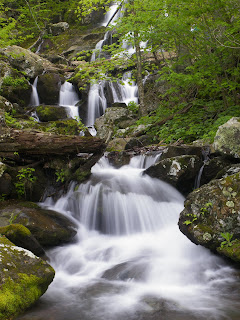May 21, 2008
In the center of Williamsport, MD is one of several Visitor Centers for the C&O Canal National Historic Park. George Washington, who lived along the Potomac, had a dream of opening a canal along this unnavigable river to promote trade with the resource-rich Ohio Valley. George was the canal company’s first president, but he did not live to see it succeed. Groundbreaking didn’t occur until 1828. After 22 years of construction, the canal only made it to Cumberland, MD, halfway to the goal of Pittsburgh. The canal was old technology. On the very same day, construction also began on the B&O railroad, and it arrived in Cumberland eight years sooner. On the park grounds is the site of the Conococheague aqueduct that carried the canal water in a bridge over a Potomac feeder stream. As we take a photo, we watch a group of cyclists beginning a ride down a section of the mule towpath. I am jealous. They have local friends that will meet them upstream and chauffeur them back.
.jpg)
From Williamsport we drive west along Maryland’s panhandle up and down innumerable ridges of the Appalachian chain. We stop at a major road cut through one of the ridges. The Sideling Hill Exhibit Center describes the geology exposed by this 340-foot high man-made mountain pass that is visible from miles away.

We then cross into Pennsylvania arriving at Fort Necessity National Battlefield. This one is really going to throw Aimee for a loop as it doesn’t pertain to the Revolutionary or Civil Wars. In 1754, France and England were both vying for the Ohio Valley. England sent 22-year old colonial George Washington to lead a group of men to construct a road from Cumberland, MD to the “forks of the Ohio” (Pittsburgh). Along the way he ran into a group of French soldiers, attacked them, killing the commander. Fearing retaliation, he quickly built a small wooden stockade, aptly named Fort Necessity. Unfortunately his defense was poor and he was forced to surrender. Not an illustrious start to a military career, especially since this incident touched off a global war. In America, it was known as the French and Indian War. We take a quick walk past the reconstructed fort (in the rain).
The Visitor Center also memorializes the National Road that was built past here. Years later, after the Revolution, George Washington bought the site of Fort Necessity, built a tavern inn, and pushed the US to build a road along his original trail, linking Cumberland, MD with the frontier. Congress eventually approved this first federally funded highway program. Begun in 1811, it was planned to end in my hometown of Alton, IL. It only made it as far as Vandalia, IL. Leaving the park we follow a very hilly US 40 along the route of this National Road, past a tollhouse and numerous taverns, into Ohio where we stay the night at Barkcamp State Park.
 May 26, 2008
May 26, 2008
.jpg)
.jpg)

.jpg)
.jpg)
.jpg)


.jpg)
.jpg)

.jpg)

.jpg)
.jpg)

.jpg)
.jpg)




.jpg)





.jpg)
.jpg)
.jpg)
.jpg)





.jpg)
.jpg)




.jpg)

.jpg)
.jpg)
.jpg)

